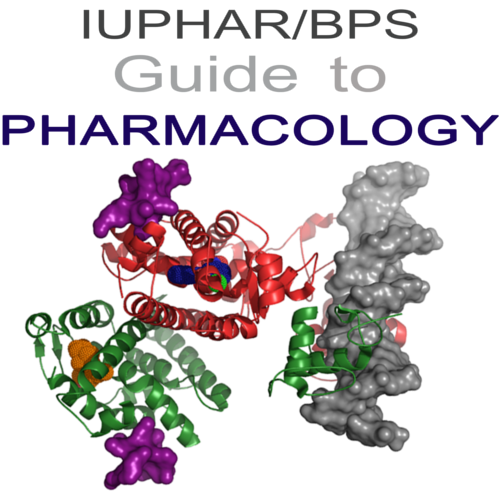Metabotropic glutamate receptors in GtoPdb v.2021.3
Abstract
Metabotropic glutamate (mGlu) receptors (nomenclature as agreed by the NC-IUPHAR Subcommittee on Metabotropic Glutamate Receptors [347]) are a family of G protein-coupled receptors activated by the neurotransmitter glutamate [138]. The mGlu family is composed of eight members (named mGlu1 to mGlu8) which are divided in three groups based on similarities of agonist pharmacology, primary sequence and G protein coupling to effector: Group-I (mGlu1 and mGlu5), Group-II (mGlu2 and mGlu3) and Group-III (mGlu4, mGlu6, mGlu7 and mGlu8) (see Further reading).
Structurally, mGlu are composed of three juxtaposed domains: a core G protein-activating seven-transmembrane domain (TM), common to all GPCRs, is linked via a rigid cysteine-rich domain (CRD) to the Venus Flytrap domain (VFTD), a large bi-lobed extracellular domain where glutamate binds. mGlu form constitutive dimers, cross-linked by a disulfide bridge. The structures of the VFTD of mGlu1, mGlu2, mGlu3, mGlu5 and mGlu7 have been solved [198, 271, 264, 399]. The structure of the 7 transmembrane (TM) domains of both mGlu1 and mGlu5 have been solved, and confirm a general helical organization similar to that of other GPCRs, although the helices appear more compacted [87, 429, 61]. Recent advances in cryo-electron microscopy have provided structures of full-length mGlu receptor dimers [189]. Studies have revealed the possible formation of heterodimers between either group-I receptors, or within and between group-II and -III receptors [88]. First well characterized in transfected cells, co-localization and specific pharmacological properties also suggest the existence of such heterodimers in the brain [266].[436, 143, 279]. Beyond heteromerization with other mGlu receptor subtypes, increasing evidence suggests mGlu receptors form heteromers and larger order complexes with class A GPCRs (reviewed in [138]).
The endogenous ligands of mGlu are L-glutamic acid, L-serine-O-phosphate, N-acetylaspartylglutamate (NAAG) and L-cysteine sulphinic acid. Group-I mGlu receptors may be activated by 3,5-DHPG and (S)-3HPG [30] and antagonized by (S)-hexylhomoibotenic acid [232]. Group-II mGlu receptors may be activated by LY389795 [265], LY379268 [265], eglumegad [350, 430], DCG-IV and (2R,3R)-APDC [351], and antagonised by eGlu [168] and LY307452 [421, 103]. Group-III mGlu receptors may be activated by L-AP4 and (R,S)-4-PPG [128]. An example of an antagonist selective for mGlu receptors is LY341495, which blocks mGlu2 and mGlu3 at low nanomolar concentrations, mGlu8 at high nanomolar concentrations, and mGlu4, mGlu5, and mGlu7 in the micromolar range [183]. In addition to orthosteric ligands that directly interact with the glutamate recognition site, allosteric modulators that bind within the TM domain have been described. Negative allosteric modulators are listed separately. The positive allosteric modulators most often act as ‘potentiators’ of an orthosteric agonist response, without significantly activating the receptor in the absence of agonist.

This work is licensed under a Creative Commons Attribution-ShareAlike 4.0 International License.










